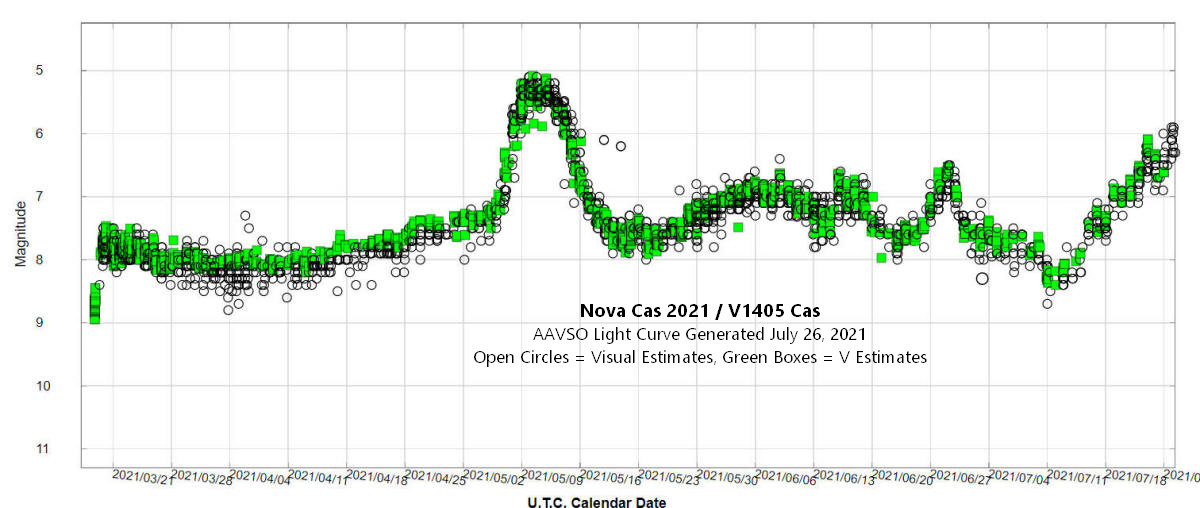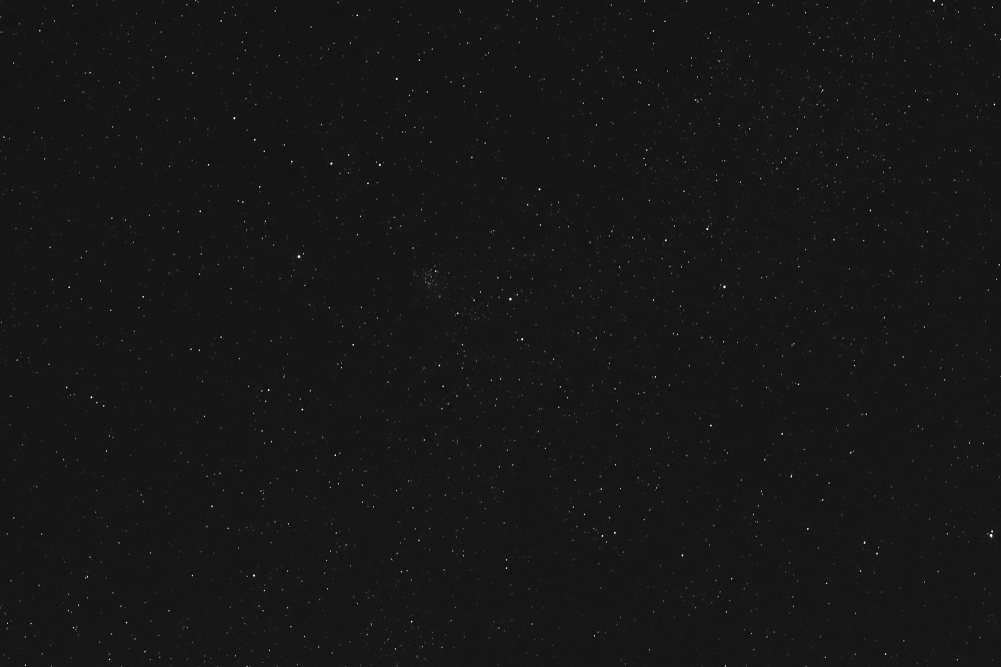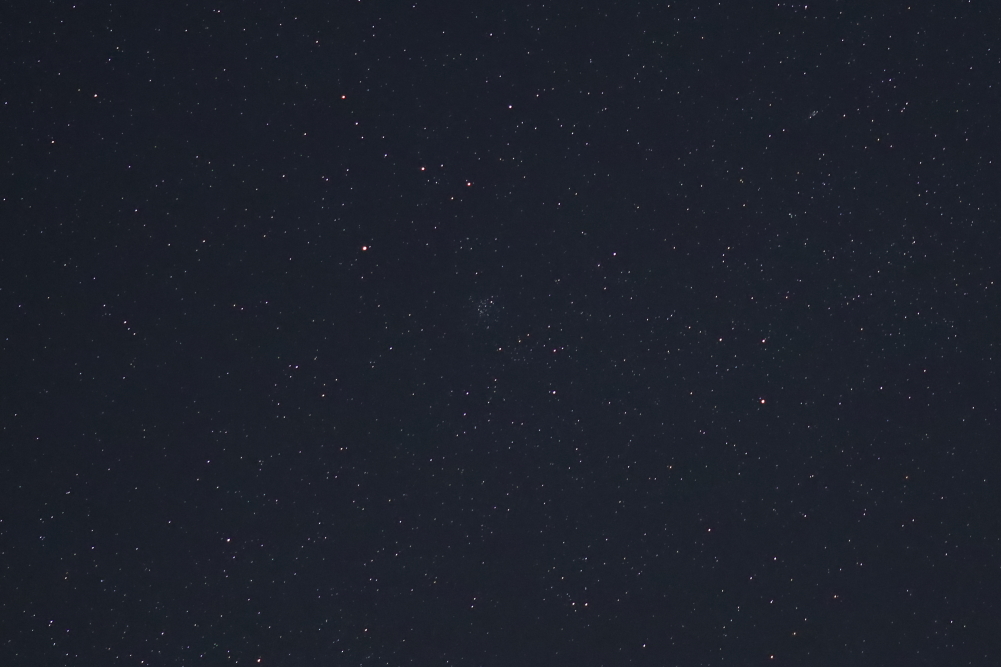SJAstro Page Index
Nova Cassiopeiae 2021 - Drops Off
July 30, 2021
|
Nova Cassiopeia 2021 was observed again from the Barnegat Road Observing
Site in the NJ Pines on July 30, 2021,
with 15x56 binoculars. It was immediately apparent that the
brightness had dropped significantly compared to July 23.
Compared to the stars HD 220819, mag 6.6, and HD 220057, mag
6.9, I estimated the nova at mag 7.0 to 7.5, which corresponded
with values on the current
light curve at AAVSO. As of this writing on Aug
4, Nova Cas 2021 is at mag 8+, comparable to the
brightness after
discovery in March 2021. |
Nova Cassiopeiae 2021 - Brightens Again
July 23, 2021

|
Nova Cassiopeia 2021 was observed again from the Barnegat Road Observing
Site in the NJ Pines on July 23, 2021, using a 130 mm,
f/7 apo
refractor with a 20 mm, 100° eyepiece (= 46x, 2.2° TFOV). With
that combination, I could easily see the Nova and nearby stars HD 220819, mag 6.6,
and HD 220057, mag 6.9, all at the same time. The nova appeared
to be between them in brightness, which is consistent with the
updated light curve shown above. The nova also displayed a mild
reddish color.
This is a screen clip of the light curve
generated from
AAVSO data for Nova Cas through July 26 and shows visual and visual
equivalent photometric magnitude estimates. The last vertical
grid line on the right represents July 25 (the vertical lines
are spaced at weekly intervals).
Click here to see the current light curve including all wavelengths. |
Nova Cassiopeiae 2021 - Outburst
May 12, 2021

|
Nova Cassiopeiae 2021 (V1405 Cas) experienced a sudden increase
in brightness on May 6-7, 2021, as detailed by Bob King in this
S&T online article. On the morning of
May 11, I was able to
observe it in a suburban sky through passing cirrus clouds with
15x56 binoculars (my casual magnitude estimate was 5.4). On the morning of
May 12, 2021, I went to the relatively dark NJ
Pines to attempt seeing it with unaided eyes. I was there from
about 3:30 until 4:15 am (astronomical twilight began at 3:58
am) and passing cirrus clouds were again present, but this time,
there were large gaps between the moving clouds. Using 8x42
binoculars, Nova Cas (estimated magnitude 5.6) was easy to see (as was nearby M52). I
think I might have glimpsed the nova a couple of times with
unaided eyes using averted vision, but they weren't certain
sightings by any means.
The image above is a single raw frame captured at 3:52 am
EDT using a
Canon EOS RP mirrorless digital camera with a Canon 200 mm
f/2.8L lens on a fixed tripod. It was exposed 2.5 seconds at
f/3.2, ISO 6400. It was slightly adjusted with Canon's Digital
Photo Professional 4, including cropping to about 48% of the
original width and height, resulting
in a field about 4.9° wide x 3.3° high. Mouseover for labels.
The numbers after the star designations are the magnitudes (sans
decimal point). Those in yellow are from AAVSO Chart X26520GZ,
those in gray are from SkyTools.
From the mid-5 magnitude range noted above, Nova Cas continued
to drop noticeably in brightness. My casual magnitude estimates
were 5.9 on May 14 (at home, 15x56), 6.6 on
May 15 (Swede Run,
15x56) and 7.2 on May 18 (Pines, 15x56 & 88 mm spotting scope).
Update: I went to Swede Run
on June 1 at 1:15 am, June 4 at 10:34 pm,
June 5 at 11:30 pm and
June 7 at 3:15 am; in each case using 15x56 binoculars on a
monopod, I estimated Nova Cas as about magnitude 6.8. On
June 10
at Carranza, using my 88 mm apo spotting scope, I estimated
magnitude 6.9. As of June
11, the AAVSO visual light
curve seems to have flattened at about magnitude 7 (for now). |
Nova Cassiopeiae 2021
April 21, 2021

|
Also on the morning of
April 21, 2021, while at Wharton State Forest, I
checked several novae that were
recently discovered when they were around eighth magnitude.
They were
Nova Cas 2021 (V1405 Cas), Nova Sgr 2021 (V6595 Sgr) and
Nova Sco 2021 No. 2 (V1710 Sco). I had already seen Nova Cas
several times from different locations using different optics,
one of which is covered further down this page. This morning,
April 21, it wasn't difficult to see Nova Cas and split the nova from a
close ninth magnitude star using 15x56 binoculars and later, the
88 mm apo spotting scope. It appeared distinctly brighter than
that star just as it did the first time I saw it. In between, it
seemed to have faded such that I saw little or no difference in
brightness between them. Correspondingly, the visual light curve
at AAVSO shows this nova starting in the magnitude 7.5 to 8
range, then dropping to the 8 to 8.5 range, and now brightening
to the 7.5 to 8 range again.
The image above includes Nova Cas and is a single raw frame
captured at 3:47 am EDT on April 21 using a
Canon EOS RP mirrorless digital camera with a Canon 200 mm
f/2.8L lens on a fixed tripod. It was exposed 2.5 seconds at
f/2.8, ISO 6400. It was slightly adjusted with Canon's Digital
Photo professional 4, including cropping to about 48% of the
original width and height, resulting
in a field about 4.9° wide x 3.3° high. Mouseover for labels. |
Nova Cassiopeiae 2021
March 22, 2021

|
Nova Cassiopeiae 2021,
now formally designated
V1405 Cassiopeiae,
was discovered on March 18, 2021, as reported in this
Sky & Telescope online article. Currently around
eighth magnitude, it's a relatively easy target for visual
observers using a small scope or binoculars, with the caveat that
this circumpolar object (for 40°N latitude) is reaching lower
culmination on March nights.
Here's a
SkyTools chart. Update:
Here's a AAVSO visual light curve generated on April 2,
2021.
This image, which includes
the nova, was captured on
March 22, 2021, from Wharton
State Forest, NJ. V1405 Cas is about 6° west-northwest of Caph
(Beta Cas), the second magnitude star at the western end of
Cassiopeia's W-shaped stick figure. This snapshot of
the area was taken
at
9:14 pm EDT with a Canon EOS RP mirrorless digital camera and a
Canon 200 mm f/2.8L telephoto lens on a fixed tripod. It's a
single raw frame exposed 2 seconds at f/2.8, ISO 3200 and 4000 K
white balance. It was mildly adjusted
in Canon's Digital Photo Professional 4 and
cropped to 40% of the original linear dimensions for a field
4.1° wide x 2.7° high.
Mouseover for labels. At the time, the nova was at 18°
altitude in the north-northwest, so it was within the
Philadelphia light dome. In addition, there was a 64%
illuminated moon at 71° altitude in Gemini, so the sky was
relatively bright, which limited exposure. Nevertheless, all
seven stars of the Little Dipper were visible with unaided eyes (albeit, the five
fainter stars required some effort to see). The weather was
relatively pleasant, 42°F with no wind. |
SJAstro.org Home Page



